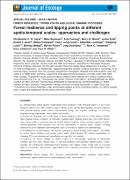Forest resilience and tipping points at different spatio-temporal scales: approaches and challenges

View/
Date
2015Author
Reyer, Christopher P. O.
Brouwers, Niels
Rammig, Anja
Brook, Barry W.
Epila, Jackie
Grant, Robert F.
Holmgren, Milena
Langerwisch, Fanny
Leuzinger, Sebastian
Lucht, Wolfgang
Medlyn, Belinda
Pfeifer, Marion
Steinkamp, Jorg
Vanderwel, Mark C.
Verbeeck, Hans
Villela, Dora M.
Metadata
Show full item recordAbstract
1. Anthropogenic global change compromises forest resilience, with profound impacts to ecosystem
functions and services. This synthesis paper reflects on the current understanding of forest resilience
and potential tipping points under environmental change and explores challenges to assessing
responses using experiments, observations and models.
2. Forests are changing over a wide range of spatio-temporal scales, but it is often unclear whether
these changes reduce resilience or represent a tipping point. Tipping points may arise from interactions
across scales, as processes such as climate change, land-use change, invasive species or deforestation
gradually erode resilience and increase vulnerability to extreme events. Studies covering
interactions across different spatio-temporal scales are needed to further our understanding.
3. Combinations of experiments, observations and process-based models could improve our ability
to project forest resilience and tipping points under global change. We discuss uncertainties in
changing CO2 concentration and quantifying tree mortality as examples.
4. Synthesis. As forests change at various scales, it is increasingly important to understand
whether and how such changes lead to reduced resilience and potential tipping points. Understanding
the mechanisms underlying forest resilience and tipping points would help in assessing
risks to ecosystems and presents opportunities for ecosystem restoration and sustainable forest
management.
Collections
- Research Articles [23]
